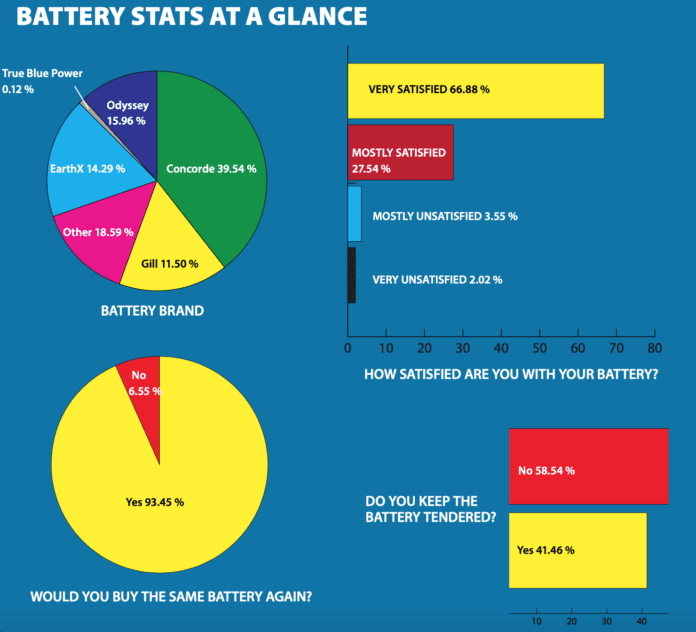Our recent battery satisfaction survey returned 3332 responses. Since the question prep was a joint effort between Aviation Consumer and sister publication KITPLANES magazine, 45 percent of the respondents own experimental aircraft and 52 percent own certificated ones. The rest were S-LSAs.
As you see in the graphics on the next page, since we surveyed the KITPLANES readership, our survey turned up experimental models from Odyssey and AeroLithium—and some interesting combinations of motorcycle, tractor and car batteries. If you own an experimental (where anything goes) and have interest in these, you can read an upcoming battery roundup article in KITPLANES.
Still, Concorde was the most popular choice at nearly 40 percent, followed by EarthX. Interestingly, only four survey respondents reported using True Blue Power models. We expected more, so we asked the company how many batteries are in the field, but it wouldn’t provide that data. As we said in the main article, we believe price is an obstacle. We were also surprised at the few numbers of Teledyne Gill models reported—barely 12 percent.
We’re pleasantly surprised that nearly 67 percent of the respondents were very satisfied with their batteries and nearly 28 percent were mostly satisfied. In our survey, the Gill brand brought more dings than we expected.
“I used Gill and I could set my watch and calendar on 24 months and be absolutely confident it would fail within a few weeks after the two- year warranty expired. The longest I ever got from my flooded Gill was we’ll less than 30 months. Not so with the AGM Concorde—where the average usable lifespan is about four years,” one respondent said. “This is my third Gill battery that has gone bad. I put one in a 1960 Cessna 310 and it lasted six months, and then I put one in my 1979 310R and it lasted six months. I switched to Concorde on both airplanes and I haven’t had any trouble,” another said. But there were happy Gill owners, too. “I’ve had outstanding service from my last three Gill batteries and only replaced them because of age,” one respondent said. We’re disappointed that the company wouldn’t talk with us (it didn’t respond by press time) about our survey results, as the other manufacturers did.
We heard more than one complaint about price. “Concorde is too expensive—$800 for a model that fits a Cessna 152. For nearly the same price I could get a lithium,” one owner said. “Prices have risen outrageously,” said another.
When it comes to warranty replacement and customer service (at a time when an owner or shop is frustrated the most), only 65 percent said they were satisfied with the outcome. When we asked why they weren’t satisfied, we heard a mixed bag. “We got no response from the company,” said one owner. “There were too many hoops to jump through to get a replacement,” an A&P said. “Return postage was the value of the credit on the battery,” another said.
HOT CLIMATES, TENDERS
While nearly 80 percent of the respondents store the aircraft in an unheated hangar, one thing we heard in the survey is how tough a hot climate is on a battery. “The Florida heat has been brutal on all of my aircraft batteries, no matter the brand,” said one. “I’m based in Arizona, and it seems the heat is the death of most of my batteries. From July to September, the internal temperature of my hangar gets to 150 degrees F. The battery, mounted in the tail baggage area, usually measures 120 degrees F,” said another.
But when asked if the battery is kept on a battery tender (not a charger), 58 percent said they did not. We’ve had excellent results properly tendering all kinds of batteries and are convinced it’s a way to increase battery life. “I currently have five Concorde batteries in four planes and I typically get five to seven years when using battery tenders. Some have lasted 10 years,” one respondent said. “Fly often and use a battery tender that’s specific to aviation batteries,” said another. “Keeping batteries on a battery tender helps, especially during data updates,” one owner told us.
Not surprisingly, 41 percent said that they don’t service the battery regularly per the manufacturer’s recommendations. “Aircraft batteries are infuriating to work with if done the manufacturer’s ‘recommended’ way. Doing a proper capacitance test using the factory tester is very time- consuming and expensive for both me and my customers, especially when compared to a modern automotive shop using a handheld tester (less than $300) that gives the same or better information,” said an A&P.
Having flattened our share of otherwise healthy batteries, we asked if external power is used when the master switch is on for longer than a few minutes—like when updating databases and software. Not surprisingly, 60 percent said they do not. Moreover, lots of respondents weren’t really sure what the aircraft’s voltage regulator is adjusted for at the upper threshold. And worse, some didn’t even know what voltage the aircraft was.
Our experience has proven that a healthy and properly adjusted charging system is the best place to start with any battery.
If you want more details on the survey results or want to share your experience with a battery, drop us a line.


